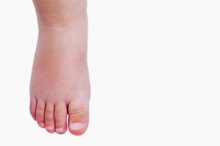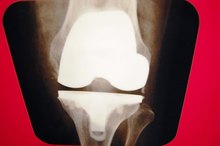Joint Pain & Fever in Children
Fever and joint pain by themselves are common symptoms in children, but together can be signs of uncommon but potentially serious conditions. If your child has fever and joint pain, it is important to note when the symptoms began, if there was a recent illness or trauma and whether the joint pain is accompanied by redness or swelling.
Significance
Certain characteristics distinguish benign conditions associated with joint pain and fever from those that are serious. For example, swelling, muscle weakness, stiffness of the joint and tenderness are all indications of a potentially serious condition. Benign conditions do not usually cause tenderness or weakness. If there is stiffness of the joint, it typically resolves with over-the-counter medicines and rest.
- Certain characteristics distinguish benign conditions associated with joint pain and fever from those that are serious.
Causes
Ankle Swelling in Children
Learn More
The most common causes of joint pain and fever in children are medical conditions such as a septic joint -- a bacterial infection of the joint fluid. Other conditions include Lyme arthritis -- a complication of Lyme disease in children, rheumatoid fever -- an inflammatory condition that can follow a strep throat infection and osteomyelitis -- a bacterial infection of the bones around the joint.
Examination
When evaluating your child with fever and joint pain, your doctor will determine which joint is involved. Children will often exhibit referred pain, which means that inflammation in one joint can be felt in another. For example, children can feel hip inflammation in the knee of the same side. Also, it is important to determine if only one joint is affected or if the condition involves multiple joints. This can narrow down the possible medical conditions associated with the symptoms.
- When evaluating your child with fever and joint pain, your doctor will determine which joint is involved.
- Also, it is important to determine if only one joint is affected or if the condition involves multiple joints.
Evaluation
What Are the Causes of Migratory Arthritis?
Learn More
The evaluation of your child with joint pain and fever involves X-rays and blood work. X-rays help determine if there is a fracture or other trauma. Common blood tests in the evaluation of a child with joint pain and fever include obtaining a complete blood count to see if the white blood cells -- cells that fight infections -- are elevated, blood cultures to detect the presence of bacteria in the blood that could be infecting the joint. Antigen levels, which can be elevated in certain autoimmune conditions like lupus and juvenile rheumatoid arthritis, are also checked.
- The evaluation of your child with joint pain and fever involves X-rays and blood work.
- Common blood tests in the evaluation of a child with joint pain and fever include obtaining a complete blood count to see if the white blood cells -- cells that fight infections -- are elevated, blood cultures to detect the presence of bacteria in the blood that could be infecting the joint.
Treatment
The treatment of a child with joint pain and fever depends on the cause. Septic arthritis needs intravenous antibiotics and surgical drainage of the affected joint's fluid. Trauma may need surgical intervention or immobilization with a splint or cast. Inflammatory conditions like arthritis may need long-term over-the-counter or prescription strength anti-inflammatory medicines. If the pain and fever is chronic and there is permanent damage to the joint, physical therapy can help diminish the long-term effects of the inflammation.
- The treatment of a child with joint pain and fever depends on the cause.
- If the pain and fever is chronic and there is permanent damage to the joint, physical therapy can help diminish the long-term effects of the inflammation.
Related Articles
References
- American Academy of Family Physicians: Chronic Musculoskeletal Pain in Children
- Gladman DD, Ritchlin C. Patient education: Psoriatic arthritis (Beyond the basics). UpToDate. Updated February 5, 2018.
- Docken WP. Clinical manifestations and diagnosis of polymyalgia rheumatica. UpToDate. Updated October 8, 2019.
- Goldenberg DL. Patient education: Fibromyalgia (Beyond the basics). UpToDate. Updated June 21, 2018.
- Centers for Disease Control and Prevention. Osteoarthritis (OA). Updated January 10, 2019.
- MedlinePlus. Osteoarthritis. Updated January 6, 2020.
- Banks SE. Erosive osteoarthritis: a current review of a clinical challenge. Clin Rheumatol. 2010;29(7):697-706. doi:10.1007/s10067-009-1369-7
- Engel B, Just J, Bleckwenn M, Weckbecker K. Treatment options for gout. Dtsch Arztebl Int. 2017;114(13):215-222. doi:10.3238/arztebl.2017.0215
- MacMullan P, McCarthy G. Treatment and management of pseudogout: insights for the clinician. Ther Adv Musculoskelet Dis. 2011;4(2):121-131. doi:10.1177/1759720x11432559
- Arthritis Foundation. Infectious arthritis.
- Marks M, Marks JL. Viral arthritis. Clin Med (Lond). 2016;16(2):129-134. doi:10.7861/clinmedicine.16-2-129
- Sierakowski S, Cutolo M. Morning symptoms in rheumatoid arthritis: a defining characteristic and marker of active disease. Scand J Rheumatol. 2011;40(sup125):1-5. doi:10.3109/03009742.2011.566433
- Spondylitis Association of America. Overview of types of spondylitis.
- National Psoriasis Foundation. Psoriatic arthritis. Updated December 28, 2018.
- Gladman DD, Ritchlin C. Patient education: Psoriatic arthritis (Beyond the basics). Updated February 5, 2018.
- National Organization for Rare Disorders. Reactive Arthritis.
- Arvikar SL, Fisher MC. Inflammatory bowel disease associated arthropathy. Curr Rev Musculoskelet Med. 2011;4(3):123-131. doi:10.1007/s12178-011-9085-8
- Lam NC, Ghetu MV, Bieniek ML. Systemic lupus erythematosus: Primary care approach to diagnosis and management. Am Fam Physician. 2016;94(4):284-94.
- Docken WP. Clinical manifestations and diagnosis of polymyalgia rheumatica. Updated October 8, 2019.
- Goldenberg DL. Patient education: Fibromyalgia (Beyond the basics). Updated June 21, 2018.
- National Institute of Diabetes and Digestive and Kidney Diseases. Hashimoto's disease. Updated September 2017.
- Jaracz J, Gattner K, Jaracz K, Górna K. Unexplained painful physical symptoms in patients with major depressive disorder: Prevalence, pathophysiology and management. CNS Drugs. 2016;30(4):293-304. doi:10.1007/s40263-016-0328-5
- Solmaz D, Bakirci S, Kimyon G, et al. The impact of having family history of psoriasis or psoriatic arthritis on psoriatic disease. Arthritis Care Res (Hoboken). 2020;72(1):63-68. doi:10.1002/acr.23836
- Fouladbakhsh J. Complementary and alternative modalities to relieve osteoarthritis symptoms: A review of the evidence on several therapies often used for osteoarthritis management. Orthop Nurs. 2012;31(2):115-121. doi:10.1097/nor.0b013e31824fce6e
- Wandel S, Jüni P, Tendal B, et al. Effects of glucosamine, chondroitin, or placebo in patients with osteoarthritis of hip or knee: network meta-analysis. BMJ. 2010;341:c4675. doi:10.1136/bmj.c4675
- American Academy of Orthopaedic Surgeons. Osteotomy of the knee. Updated June 2017.
- Marks M, Marks JL. Viral arthritis. Clin Med (Lond). 2016 Apr;16(2):129-34. doi:10.7861/clinmedicine.16-2-129
- Pujalte G, Albano-Aluquin SA. Differential Diagnosis of Polyarticular Arthritis. Am Fam Physician. 2015 Jul 1;92(1):35-41.
- Shmerling RH. (2017). Evaluation of the adult with polyarticular pain. Maini RN, ed. UpToDate. Waltham, MA: UpToDate Inc.
- Skou ST, Roos EM, Laursen MB, et al. A Randomized, Controlled Trial of Total Knee Replacement. N Engl J Med. 2015;373(17):1597-1606. doi:10.1056/NEJMoa1505467
Writer Bio
Ruben J. Nazario has been a medical writer and editor since 2007. His work has appeared in national print and online publications. Nazario is a graduate of the University of Louisville School of Medicine, and is board-certified in pediatrics. He also has a Master of Arts in liberal studies from Skidmore College in Saratoga Springs, N.Y.









